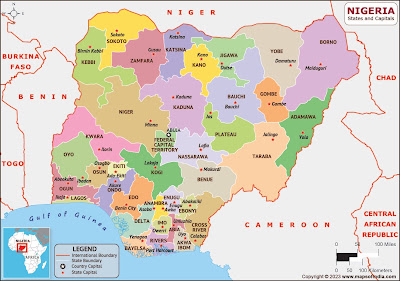Nigeria, often called “The Giant of Africa,” is a vibrant, diverse, and dynamic country in West Africa. Known for its bustling cities, Nollywood films, Afrobeat rhythms, diverse cultures, and natural wonders, Nigeria offers travelers an energetic, colorful African experience.
Discover Nigeria
📍 Location: Located in West Africa, bordered by Benin, Niger, Chad, Cameroon, and the Atlantic Ocean along its southern coast.
🏞️ Diverse Landscapes: From coastal beaches to savannah, rainforests, and plateaus, Nigeria’s landscapes are as diverse as its people.
🏙️ Mega-Cities: Lagos and Abuja pulse with energy, commerce, creativity, and culture.
🎶 Cultural Powerhouse: Nigeria’s music, film, and fashion industries shape trends across Africa and the world.
Top Places to Visit in Nigeria
🏙️ Lagos: Nigeria’s largest city and economic hub, with lively markets, beaches, art galleries, and vibrant nightlife.
⛰️ Abuja: The modern capital, home to the impressive Zuma Rock and Aso Rock, with organized city planning and green spaces.
🏞️ Yankari National Park: Nigeria’s premier wildlife reserve, offering sightings of elephants, baboons, and hot springs.
🌊 Calabar: A gateway to the Cross River National Park and known for the colorful Calabar Carnival.
🌿 Erin Ijesha Waterfall: A beautiful, multi-level waterfall located in Osun State.
🏝️ Lekki Conservation Centre: A protected coastal area in Lagos, known for its canopy walkway and wildlife.
Culture and Traditions
✨ Ethnic Diversity: Home to over 250 ethnic groups, including Yoruba, Igbo, Hausa-Fulani, Edo, and many others, each with distinct traditions and festivals.
✨ Festivals: The Eyo Festival in Lagos, Osun-Osogbo Festival in Osun State, and Durbar Festival in the north showcase Nigeria’s rich heritage.
✨ Music and Dance: From Afrobeat and Afropop to traditional drumming, Nigeria’s music scene is globally influential.
✨ Film Industry: Nollywood, Nigeria’s film industry, is one of the largest in the world, producing vibrant, culturally rich films.
Nigerian Cuisine
🍚 Jollof Rice: A popular rice dish cooked with tomatoes, peppers, and spices, often served with chicken or fish.
🥘 Egusi Soup: Made from melon seeds, vegetables, and meat, served with pounded yam or fufu.
🍗 Suya: Spicy grilled meat skewers, often enjoyed as street food.
🍞 Akara: Fried bean cakes, popular for breakfast.
🍌 Dodo: Fried plantains, served as a side dish.
🥤 Zobo Drink: A refreshing hibiscus tea, often flavored with ginger and pineapple.
Why Visit Nigeria?
✅ Cultural Diversity: Festivals, crafts, and daily life offer deep cultural immersion.
✅ Energetic Cities: Lagos and Abuja offer art, music, food, and nightlife.
✅ Natural Wonders: National parks, waterfalls, and beautiful coastlines.
✅ Culinary Exploration: Flavorful dishes that reflect the nation’s diversity.
✅ Music and Arts: Experience Afrobeat, Nollywood, and local crafts firsthand.
Practical Travel Tips
🛂 Visa: Most visitors require a visa; check with Nigerian embassies or consulates.
🌤️ Best Time to Visit: November to March during the dry season for ease of travel.
🗣️ Language: English is the official language, with Yoruba, Igbo, Hausa, and many others spoken across regions.
👗 Dress Appropriately: Light clothing for hot weather, with modest dress in rural and religious areas.
Final Thoughts 🌍✨
Nigeria is a country where energy, creativity, and culture blend seamlessly, offering travelers a vibrant, unforgettable African journey. Whether exploring Lagos’s art galleries, attending a colorful festival, tasting spicy jollof rice, or enjoying Afrobeat rhythms, Nigeria is an experience you will carry with you.
✈️ Curious about Africa’s 54 unique countries?
Explore them all on our Africa Main Page.
🏠 For more art, travel, and cultural stories, visit our CRA ARTS Main Page.
Have you experienced Nigeria’s vibrant culture or dreamt of attending its festivals? Share your thoughts or questions below!

Comments
Post a Comment